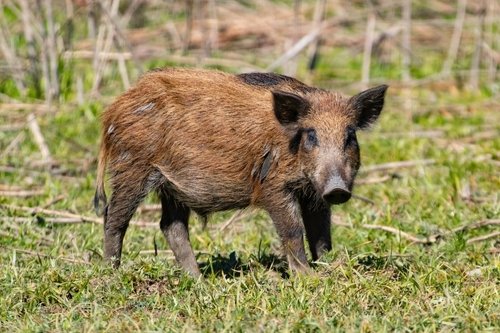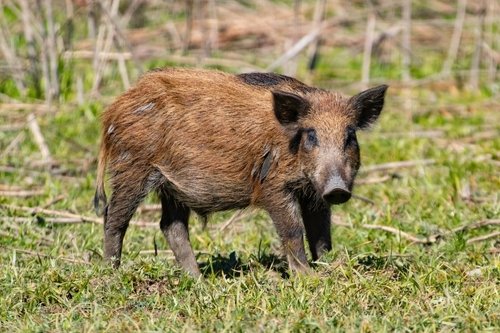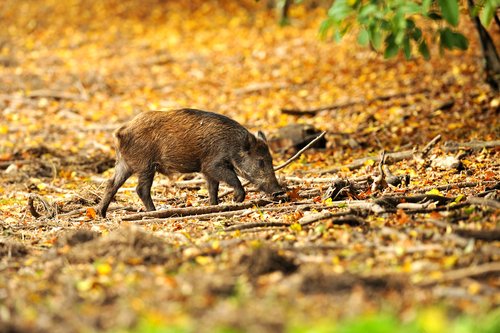Exploring the Best Hog Hunting Spots in the Midwest
Picture this: a vast expanse of rolling plains and dense forests where hunters brave the elements in pursuit of a formidable quarry. Welcome to the world of Midwest hog hunting – an adrenaline-fueled adventure that has captivated hunters for generations.
But what exactly is hog hunting, and why is it so significant in this region? Hog hunting refers to the pursuit and harvesting of wild hogs, also known as feral pigs or swine.
These intelligent creatures, descendants of domesticated pigs gone wild, have established thriving populations across many states in the American Midwest. Hog hunting has become integral to the region’s cultural fabric, offering a thrilling outdoor experience for seasoned hunters and newcomers alike.
A Battle Against an Invasive Force: The Rise of Wild Hogs
To understand the significance of hog hunting in the Midwest, we must delve into its history. Wild hogs can be traced back to European settlers who brought domesticated pigs to North America centuries ago.
Over time, some escaped or were purposefully released into the wild, adapting remarkably well to their new habitat. These highly adaptable creatures rapidly multiply and spread across vast areas, wreaking havoc on ecosystems.
Their voracious appetite led them to destroy crops and natural vegetation while disrupting native wildlife habitats. As their numbers soared, it became evident that action was needed to control their population growth.
That’s where hog hunting comes into play. As a means of population control and preventing further ecological damage, hunters have taken up arms against these invasive beasts.
With each hunt, they contribute to environmental preservation and help safeguard agriculture in the region from significant losses caused by rampant feral pig populations. So strap on your boots and prepare for an unforgettable adventure as we delve deeper into the world of Midwest hog hunting.
From the techniques and equipment to the regulations and cooking tips, we’ll cover it all to help you embark on your own thrilling hog hunting journey in the heartland of America. Stay tuned for more Midwest hog hunting tips and insights!
Understanding Wild Hogs
Characteristics and Behavior of Wild Hogs
Wild hogs, also known as feral pigs or wild boars, are formidable creatures with unique characteristics. These adaptable animals are typically large, with males weighing up to 300 pounds. They have muscular bodies covered in coarse hair ranging from black to brown and can even display stripes along their backs.
One striking feature of wild hogs is their impressive tusks, which can grow up to several inches long. These fearsome weapons are used for fighting and defense.
When it comes to behavior, wild hogs are highly intelligent and resourceful. They are opportunistic omnivores that feed on various plant matter, insects, small mammals, and even carrion.
Their keen sense of smell allows them to locate food from great distances, making them adept foragers in various environments. Wild hogs have adapted well to the diverse terrain found throughout the Midwest region.
Impact of Wild Hogs on the Environment and Agriculture
While wild hogs may seem fascinating due to their resilience and adaptability, they can wreak havoc on the environment and agriculture. The Midwest has witnessed the negative consequences caused by expanding hog populations firsthand. In terms of environmental impact, wild hogs engage in destructive rooting behavior as they search for food sources below the ground surface.
Their powerful snouts dig deep into soil layers, causing significant damage to vegetation and disrupting ecosystems. This rooting activity contributes to soil erosion and alters native plant communities by outcompeting other species.
Furthermore, wild hogs substantially threaten agricultural operations in the Midwest. They can cause extensive damage to crops such as cornfields or hay fields by trampling over plants or consuming large quantities of produce quickly.
This leads to financial losses for farmers and affects food availability for both humans and native wildlife. Controlling the wild hog population through regulated hunting has become crucial to mitigate these detrimental effects.
Understanding the characteristics and behavior of wild hogs and their impact on the environment and agriculture is essential for effective Midwest hog hunting. By comprehending their habits and the damage they can cause, hunters can play a vital role in managing this invasive species while enjoying an exhilarating outdoor experience in the heart of the Midwest.
Popular Hog Hunting Locations in the Midwest
Overview of states with thriving hog populations
When it comes to hog hunting, the Midwest is a region that offers plenty of excitement for hunters. Several states in this region have seen their wild hog populations increase. Among them, Texas and Oklahoma are undoubtedly at the forefront.
These states boast large areas of prime hog hunting land, providing ample opportunities for hunters to test their skills. In addition to Texas and Oklahoma, other states like Missouri, Arkansas, and Louisiana have notable hog populations.
While these states may not have hogs as abundant as Texas, they still offer rewarding hunting experiences. So, if you’re ready to embark on a thrilling hog-hunting adventure without straying too far from home, these Midwest states are excellent options.
Highlighting specific regions known for hog hunting opportunities
Within these hog-populated states in the Midwest, specific regions stand out as hotspots for hog-hunting enthusiasts. For instance, in Ohio, you’ll find some fantastic opportunities for hog hunting near areas such as Ross County and Highland County. These regions offer a mix of open fields and dense forests where hogs tend to thrive.
Moving further south into Georgia and Alabama, you’ll discover prime locations like Harris County and Chattahoochee National Forest, renowned for their bountiful hog populations. The varied terrain in these areas gives hunters a range of options regarding tactics and strategies.
Whether you’re looking for vast open spaces or dense forests teeming with wildlife, the Midwest has diverse regions catering to different hog hunting preferences. So pack your gear and get ready to explore the exciting world of Midwest hog hunting!
Hunting Methods and Techniques
Traditional Hunting Methods: Firearms and Archery
Regarding hog hunting in the Midwest, two traditional methods have stood the test of time: firearms and archery. Both methods require skill, patience, and precision. Firearms are the go-to choice for many hog hunters due to their long-range effectiveness.
Rifles are commonly used, with popular calibers including .308 Winchester, 6.5 Creedmoor, and .30-06 Springfield. These cartridges provide enough power to take down a wild hog with a well-placed shot.
Shotguns with slugs can also be effective at closer ranges. On the other hand, archery offers a more up-close and personal experience for hog hunters seeking a challenge.
Compound bows are favored for their power and accuracy, while some hunters prefer the simplicity of traditional recurve or longbows. When using archery equipment for hog hunting in Ohio or any other Midwest state, broadheads designed for the big game should be employed to ensure clean kills.
Alternative Methods: Trapping and Dog Hunting
In addition to firearms and archery, alternative methods such as trapping and dog hunting have gained popularity among Midwest hog hunters looking for different experiences. Trapping wild hogs involves setting up traps that capture them alive or kill them instantly upon entry. Common types of traps include corral traps with gates that close behind the hogs as they enter an enclosed area or cage traps equipped with trigger mechanisms.
This method allows hunters to catch multiple hogs at once but requires careful planning regarding trap placement. Dog hunting is another alternative technique where well-trained dogs track down hogs by scent and hold them at bay until the hunter arrives for the harvest.
This method requires skilled dogs trained specifically for tracking hogs’ distinct scent patterns while ensuring their safety during confrontations. It can be an exhilarating experience for hunters who enjoy the teamwork between humans and canines.
Discussion on Baiting Techniques and Strategies
When effectively hunting hogs in the Midwest, employing baiting techniques can significantly increase your chances of success. Baiting involves strategically placing food sources to lure hogs into specific areas, making them easier targets. Commonly used baits for hunting include corn, fermented grains, fruits, and specialized commercial hog attractants.
The key is to position the bait where hogs frequently travel or feed, such as near water sources or rooting areas. Baiting techniques also vary depending on the chosen method of hunting.
For firearms or archery hunters, setting up a stand near a baited area provides a chance for a clean shot when hogs come to feed. Trappers may set up their traps near the bait source to capture hogs efficiently.
Dog hunters often use bait to attract hogs within range of their dogs’ tracking abilities for safe encounters. Before implementing any baiting strategies or techniques; it is essential to check state regulations regarding legal requirements and restrictions on hog hunting in your specific Midwest location.
Gear and Equipment for Hog Hunting
Firearms suitable for hog hunting (rifles, shotguns)
When it comes to hog hunting, having the right firearm is essential. Rifles and shotguns are the most commonly used firearms for this pursuit.
Rifles chambered in .308 Winchester, .30-06 Springfield, or .270 Winchester are popular due to their versatility and power. These calibers provide sufficient kinetic energy to take down hogs effectively.
Shotguns, on the other hand, are favored for close-range encounters or when hunting in dense cover. A 12-gauge shotgun loaded with slugs or buckshot can deliver devastating stopping power.
Recommended calibers and ammunition types
For rifle hunters, it is crucial to choose appropriate ammunition that matches the caliber of their firearm. Medium- to large-sized game rounds such as Hornady SST or Nosler Partition bullets are highly recommended for hogs. These projectiles offer controlled expansion and deep penetration necessary for a clean kill on sturdy animals like hogs.
Shotgun hunters should consider using rifled slugs or buckshot loads specifically designed for big game hunting. Rifled slugs provide accuracy at longer ranges, while buckshot offers multiple projectile hits at close quarters.
Optics and accessories for improved accuracy
To increase accuracy during Midwest hog hunts, hunters often equip their firearms with optics like scopes or red dot sights. A quality scope with variable magnification allows precise shot placement at varying distances in diverse terrain. Red dot sights offer quick target acquisition and better situational awareness in fast-paced encounters.
Accessories like bipods or shooting sticks can also be valuable additions to stabilize your rifle when aiming for a static position. These aids enhance accuracy by minimizing movement caused by shaky hands or uneven ground surfaces.
Archery equipment options (bows, broadheads)
For those who prefer the challenge of hunting hogs with a bow, there are several equipment options to consider. Compound bows are the go-to choice for most hunters due to their high energy output and adjustability.
These bows provide faster arrow speeds and better accuracy, making them suitable for Midwest hog hunting, where shooting distances vary. Regarding broadheads, mechanical expandable or fixed-blade broadheads with a cutting diameter of at least 1.5 inches are recommended for hog hunting.
Both types offer effective penetration and tissue damage necessary for a lethal shot. It is worth noting that while compound bows are commonly used, traditional bows such as recurve or longbows can also be used for hog hunting with proper skill and practice.
These traditional bows offer a unique experience and require greater proficiency in shot placement due to their lower arrow speeds. Whether opting for firearms or archery equipment, selecting the right gear suited to your style and preferences is vital for successful Midwest hog hunting expeditions.
Safety Considerations in Hog Hunting
Importance of proper firearm handling and safety protocols
When engaging in the thrilling pursuit of hog hunting, it is crucial to prioritize safety above all else. Whether you’re a seasoned hunter or a beginner venturing into Midwest hog hunting, understanding and following proper firearm handling and safety protocols is paramount. Always treat your firearm as loaded, even when you know it’s not.
Maintain control of your muzzle direction, ensuring it’s pointed safely away from yourself and others. Furthermore, keep your finger off the trigger until you have identified a target and consciously decided to shoot.
Firearm safety rules to follow while hunting hogs
Ad adhere to essential firearm safety rules to ensure a secure and enjoyable hog hunting experience. Firstly, never point your gun at anything you don’t intend to shoot – this includes people, animals, or objects.
Secondly, identify your target before pulling the trigger; hog hunting often occurs in dense vegetation or low-light conditions where visibility may be limited. Always maintain situational awareness and positively identify your target before taking any shot.
Protective gear recommendations (ear protection, blaze orange)
While focusing on the excitement of bagging that prized wild hog in Ohio or any other Midwest location, one must not overlook the importance of protective gear. When it comes to hearing protection while shooting firearms during hog hunts or any other activity involving loud noises, earmuffs or earplugs are indispensable accessories for safeguarding against potential hearing damage. Incorporating blaze orange into your attire can significantly enhance safety during hog hunts.
Wearing a blaze orange hat or vest makes you more visible to other hunters in the area and prevents accidental shootings due to mistaken identity – an unfortunate but avoidable mishap. Safety is an integral part of hog hunting, and taking these precautions can help ensure a safer and more enjoyable experience.
Hazards associated with wild hogs (aggressive behavior, diseases)
While the pursuit of wild hogs in the Midwest can be exhilarating, it is important to remain aware of potential hazards that may arise during encounters with these animals. Wild hogs can exhibit aggressive behavior when threatened or cornered. They possess sharp tusks and are capable of causing serious injury.
Therefore, it is crucial to maintain a safe distance from the animal while hunting and to exercise caution when approaching wounded or trapped hogs. Furthermore, wild hogs are known carriers of diseases such as brucellosis and pseudorabies, which can pose risks to humans and other animals.
Handling hog carcasses with gloves and taking necessary precautions while field dressing or processing the meat is wise to minimize any potential exposure. Staying informed about local disease concerns and practicing good hygiene when handling wild hog meat will help mitigate any health risks associated with hog hunting in the Midwest.
Being well-versed in firearm safety protocols, utilizing appropriate protective gear such as ear protection and blaze orange attire, and remaining cautious of aggressive behavior and potential diseases associated with wild hogs are all essential for a safe hog hunting experience in the Midwest. By prioritizing safety at every step, hunters can enjoy their time in nature while minimizing unnecessary risks.
Hunting Regulations and Licensing Requirements
State-specific regulations on hog hunting
Regarding hog hunting in the Midwest, it’s crucial to understand and abide by the state-specific regulations governing this activity. Each state has its own set of rules and guidelines designed to ensure hunters’ safety, protect wildlife populations, and maintain a balance with agricultural interests. Let’s take a closer look at hog hunting regulations in a few states:
Ohio: In Ohio, wild hogs are considered nuisance animals. Therefore, there are no specific seasons or bag limits for hog hunting.
However, hunters must possess a valid hunting license and adhere to all other established hunting regulations. Additionally, landowners experiencing hog-related damage can obtain special permits to control hog populations on their property.
Indiana: Indiana allows year-round hunting of wild hogs on private and public lands. Hunters need a valid hunting license unless they qualify for exemptions, such as youth hunters or landowners/tenants on their property.
Hunters must check with the Indiana Department of Natural Resources for additional restrictions or specific area regulations. Illinois: Hog hunting in Illinois follows the same season dates as deer hunting seasons, which vary depending on the county.
Hunters must have a valid deer permit and proper licenses to harvest hogs during deer season. Outside of deer season, hogs can be hunted without additional permits or fees.
Licensing requirements for residents/non-residents
The licensing requirements for hog hunting differ between residents and non-residents in most Midwest states. Residents typically have more flexibility when obtaining licenses, while non-residents may face certain limitations or require additional permits. For example:
Residents: In states like Ohio and Indiana, residents who wish to hunt wild hogs need a valid resident hunting license, which can be obtained from their respective state’s Department of Natural Resources or a licensed retailer. The cost of the license varies depending on factors such as age and duration (annual, lifetime, etc.).
Non-residents: Non-residents often have the opportunity to hunt wild hogs in Midwest states, but they may need to acquire specific non-resident hunting licenses. These licenses typically come with higher fees than resident licenses and may have limited availability or require a lottery system for certain areas.
It’s essential for hunters, both residents and non-residents, to carefully review the licensing requirements in each state where they plan to hunt hogs. Additionally, checking if any additional permits or stamps are necessary before heading out into the field is advisable.
Staying informed about these regulations ensures a successful and legally compliant hog hunting experience in the Midwest. Remember, it is always best to consult your state’s Department of Natural Resources or check their website for the most up-to-date information regarding hog hunting regulations and licensing requirements.
Cooking Tips for Wild Hog Meat
Preparing wild hog meat for cooking
Proper preparation is key when cooking wild hog meat to ensure a mouthwatering and tender dining experience. Before diving into the culinary adventure, it’s crucial to understand that wild hog meat can have a stronger flavor than commercially raised pork.
To mellow out any gamey undertones, it’s recommended to soak the meat in a marinade or brine for a few hours or even overnight. This not only helps in tenderizing the meat but also imparts wonderful flavors.
Before marinating, remember to trim off any excess fat from the hog meat, as it can become greasy when cooked. Removing silver skin (a thin membrane found on some cuts) will improve tenderness.
When marinating, choose ingredients like citrus juices, vinegar, herbs, and spices that complement the bold flavor of wild hog meat. You can opt for classic marinades with garlic and rosemary or explore bolder flavors with Asian-inspired blends using soy sauce and ginger.
Delicious recipes using different cuts of wild hog meat
Once you’ve prepared your wild hog meat for cooking, it’s time to explore some delectable recipes that will truly showcase its natural flavors. Let’s dive into some mouthwatering options based on the different cuts of this versatile game.
For pork chops or loins: A simple yet flavorful approach is to marinate them in olive oil, minced garlic, fresh herbs like thyme or rosemary, salt, and pepper. Grill them over medium-high heat until they reach an internal temperature of 145°F (63°C) for optimal juiciness.
If you have ground wild hog meat, Try making delicious juicy burgers by mixing the ground meat with breadcrumbs soaked in milk (for added moisture), finely chopped onions, Worcestershire sauce, and seasonings like paprika or cayenne pepper. Shape them into patties and grill or pan-fry until cooked through.
Regarding slow-cooking tougher cuts like shoulder or ham, Consider making pulled pork. Rub the meat with brown sugar, chili powder, garlic powder, salt, and black pepper.
Place it in a slow cooker with some liquid (broth or apple cider), and cook on low for 8-10 hours until it becomes tender enough to shred easily. Serve it on buns with your favorite barbecue sauce for a finger-licking good meal.
These are just a few examples of the endless possibilities when cooking wild hog meat. Feel free to experiment with different flavors, techniques, and cuisines to create your signature dishes that will keep you coming back for more after every successful hog-hunting trip in the Midwest!
Conservation Efforts to Preserve Midwest Hog Hunting
As hog hunting in the Midwest continues to gain popularity, a growing concern exists over maintaining a sustainable hog population. While hogs may be seen as pests due to their destructive impact on the environment and agriculture, conservation efforts are crucial to ensure a balanced ecosystem. Various organizations and agencies have taken steps to manage hog populations responsibly.
One notable example is the partnership between local hunters and state wildlife agencies. These collaborations involve initiatives such as controlled hunts and trapping programs, which aim to reduce hog numbers in areas that pose significant threats.
Additionally, educational campaigns are being conducted to raise awareness among hunters about the importance of selective harvesting, proper disposal of carcasses, and reporting hog sightings. By working hand-in-hand with conservation groups and implementing effective management strategies, we can help preserve the thrill of Midwest hog hunting for future generations.

Conclusion: The Thrill of Midwest Hog Hunting
Hog hunting in the Midwest offers an exhilarating experience for both seasoned hunters and newcomers. The vast landscapes, abundant opportunities, and challenging encounters with wild hogs make it an unforgettable venture. Hunters can embark on successful excursions throughout states like Ohio with proper knowledge of hog behavior, suitable gear selection, and adherence to safety regulations.
Moreover, we can contribute to sustaining this cherished tradition for generations to come through responsible hunting practices and active participation in conservation efforts focused on preserving a healthy ecosystem balance. So, gear up with your rifles or bows!
Be prepared with your adventurous spirit! And let the thrill of Midwest hog hunting take you on an exciting journey filled with adrenaline-pumping moments!






